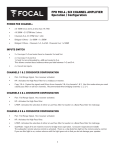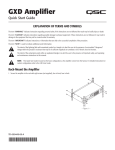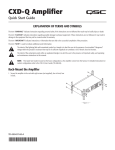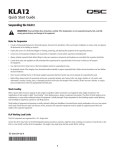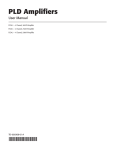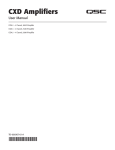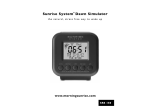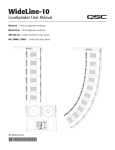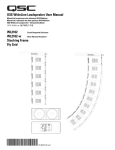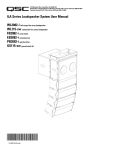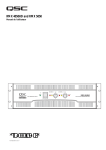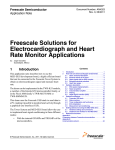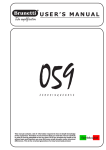Download Quick Start Guide - English
Transcript
PLD Amplifier Quick Start Guide EXPLANATION OF TERMS AND SYMBOLS The term “WARNING!” indicates instructions regarding personal safety. If the instructions are not followed the result may be bodily injury or death. The term “CAUTION!” indicates instructions regarding possible damage to physical equipment. If these instructions are not followed, it may result in damage to the equipment that may not be covered under the warranty. The term “IMPORTANT!” indicates instructions or information that are vital to the successful completion of the procedure. The term "NOTE" is used to indicate additional useful information. The intent of the lightning flash with arrowhead symbol in a triangle is to alert the user to the presence of un-insulated "dangerous" voltage within the product's enclosure that may be of sufficient magnitude to constitute a risk of electric shock to humans. The intent of the exclamation point within an equilateral triangle is to alert the user to the presence of important safety, and operating and maintenance instructions in this manual. NOTE: This Quick Start Guide is based on the basic configuration as the amplifier comes from the factory. Four separate inputs, and four separate outputs. For detailed instructions for custom configurations refer to the PLD User Guide (TD-000368). Rack-Mount the Amplifier 1. Secure the amplifier in the rack with eight screws (not supplied), four in front, four in back. — Figure 1 — TD-000351-00-B *TD-000351-00* 1 Connections Inputs 1. Wire the audio line-level source to four male XLR connectors. You may use either balanced inputs (Figure 2) or unbalanced inputs (Figure 3). 2. Plug the male XLR connectors into the appropriate receptacles (Routable Inputs 1, 2, 3, 4) Figure 4. If you are daisy-chaining inputs with another amplifier, plug the female XLR connectors, from the other amplifier, into the XLR's on the bottom row of the Routable Inputs. — Figure 2 — — Figure 3 — — Figure 4 — 3. Connect the IEC power cord to the AC receptacle on the rear of the amplifier. (Figure 5) WARNING!: Do not turn the amplifier on at this time. — Figure 5 — Outputs When the output configuration of the amplifier changes, the Outputs to the loudspeakers change accordingly. Connect the loudspeakers to the NL4 twist-lock connectors as shown in Figure 6 thru Figure 8. After connecting the Outputs to the Loudspeakers, you may turn the amplifier on. Separate Channels (A B C D) For Four Separate Cables Use four 2-wire cables, connect to: • 1+/1- on connectors #1 thru #4 For Bi-amp Operation 1 2 5 3 4 6 Use two 4-wire cables, connect to: • 1+/1- for CH A and 2+/2- for CH B on connector #1 • 1+/1- for CH C and 2+/2- for CH D on connector #3 A B C D 8.0 8.0 8.0 8.0 625 625 625 625 625 625 625 625 — Figure 6 — 2 Bridged (A+B) and Separate (C D ) Channels For A+B (Bridged) Use one 2-wire cable connect to: • 1+/1- on connector #5 For C & D (Separate) Use two 2-wire cables connect to: • 1+/1- for CH C on connector #3 •1+/1- for CH D on connector #4 Bi-amp operation, use one 4-wire cable connect to: • 1+/1- for CH C on connector #3 • 2+/2- for CH D on connector #3 A+B C D A+B 8.0 8.0 8.0 8.0 8.0 1250 625 625 1250 1250 1250 625 625 1250 1250 1 2 5 3 4 6 C+D — Figure 7 — Parallel Channels (ABCD) For Multiple Loudspeakers Full power for multiple loudspeakers in parallel Use up to four 2-wire cables, connect to: • 1+/1- on connectors #1 thru #4 1 2 5 3 4 6 For One Loudspeaker Full power to one loudspeaker Use one 2-wire cable, connect to: • 1+/1- on connector #1, #2, 3#, or #4 ABCD 8.0 2500 2500 — Figure 8 — PLD Amplifier Signal Flow Output Processing Input Settings Amp Configuration Sensitivity Switch Meter Gain 1 Source Select Mute Highpass Filter Gain / Polarity Lowpass Filter 5-band PEQ Delay RMS / Peak Limiter Meter A Sensitivity Switch Meter Gain 2 Source Select Mute Highpass Filter Gain / Polarity Lowpass Filter 5-band PEQ Delay RMS / Peak Limiter Meter B Sensitivity Switch Meter Gain 3 Source Select Mute Highpass Filter Gain / Polarity Lowpass Filter 5-band PEQ Delay RMS / Peak Limiter Meter C Sensitivity Switch Meter Gain 4 Source Select Mute Highpass Filter Gain / Polarity Lowpass Filter 5-band PEQ Delay RMS / Peak Limiter Meter D Button Actuated Crossover — Figure 9 — 3 Set by Wizard Amplifier Control ENTER Button Off Mode • Navigates into the menu structure • Enters the edit mode for adjusting parameters • Confirms the changes you make • Rear power switch is off, the amplifier is not operable. The power switch is the AC Mains disconnect. • The power button is not illuminated. • Turn the power switch to on. The amplifier enters the Run Mode. • The power button is illuminated blue. EXIT Button ENTER EXIT • Navigates out of the menu structure and parameter selection. • In the edit mode, pressing EXIT reverts the value back to its prior state, and exits the edit mode. Run Mode HOME Button • From Standby or Mute All modes, press and release the power button on the front panel. • The power button is illuminated blue. • The amplifier is fully operable; audio can pass. • If you are on the Home screen, pressing HOME displays the alternate Home screen. Pressing HOME again returns you to the primary Home screen. • If you are on a navigation screen, pressing HOME takes you to the home screen. • If you are on an edit screen, pressing HOME will confirm any value being edited and take you to the Home screen. Standby Mode • From Mute All or Run modes, press and hold the power button on the front panel. • The power button illuminates solid red. • The amplifier is not operable; audio will not pass. GAIN Button HOME GAIN • Pressing the GAIN button from any screen takes you to the output gain screen for the most recently accessed output channel. • Pressing GAIN again confirms the gain change and returns to the screen you were on when you pressed GAIN. Mute All Mode • From the Run Mode, press and release the power button. • The power button flashes red. • The front panel and DSP functionality are fully operable. Any changes you make are saved and take effect in the Run Mode. SEL Buttons SEL • Use these buttons to navigate between input channels or output channels. For example, if you are adjusting output gain on channel A, pressing the channel B SEL button takes you to the gain adjustment for channel B. • The SEL buttons are active only when the LCD screen is on an input or output parameter adjustment screen. Master Control Knob • Scrolls up/down and right/left to select menu items and parameters • Adjusts parameters Menu Tree Presets Inputs Outputs Utilities Preset Recall Input Sensitivity Source Select Status Preset Save Input Gain Processing Amp ID Preset Wizard Array Correction* Display Crossover Lockout PEQ Password Delay Limiter Load Speaker *For QSC Line Arrays only Save Speaker — Figure 10 — 4 Screen Types Informational Informational screens, like the HOME screen, are designed to provide you with a good amount of useful information at a glance. Preset # and Configuration Location and breadcrumbs F1: Config - A B C D Home (Press HOME for more information) Full Full Full Full A - FR +1.5 dB B - FR +3.5 dB C - FR +1.5 dB D - FR +1.5 dB AC Voltage: 121 V Channel Configuration and Gain AC Voltage and Current AC Current: 7.2 A Amplifier Status Amp Status: OK — Figure 11 — Navigational Navigational screens provide the means to move around and select menu items. Use the Master Control knob, ENTER and EXIT buttons for navigation. This is an example of one type of navigational screen, there are others. Preset # and Configuration Location and breadcrumbs F1: Config - A B C D Menu Empty area indicates no selections above (CCW). PRESETS Current Menu Selection Preset Recall and Save Next Menu selection below (CW) INPUTS — Figure 12 — Parameter Editing F1: Config - A B C D Output A 20 dB Parameter Editing screens allow you to select, edit, and confirm changes for various system parameters. Use the ENTER button to edit and confirm changes to parameters. Use the Master Control knob to select parameter, and make adjustments. Use the EXIT button to exit the edit mode without saving changes. Parameter being edited Parameter not selected Parameter selected -60 dB Gn/Pol Gain -7.0 dB Polarity POL+ Gain -7.0 dB — Figure 13 — Presets The PLD amplifiers are preset driven, so to get the most out of the amplifiers an understanding of how presets work is essential. A Preset, in the context of the PLD amplifiers, is a combination of amplifier configuration and DSP processing; as a preset is recalled it can change the output routing and wiring and/or any DSP processing. Preset Creation A preset can be created in two ways, the first is to modify an existing preset, then save this as a new Preset; the second is to use the Preset Wizard to create a Preset from scratch. Preset Wizard The Preset Wizard simplifies the preset creation process, and allows the user to create a preset from the ground up. The Wizard provides a mechanism for the user to select his desired power and load. Based on these selections, the best amplifier configuration is selected and the user is then allowed to select and assign loudspeakers to each output. 5 To start the Wizard: HOME > PRESETS > PRESET WIZARD > ENTER STEP 1 — Adjust Impedance and Power OUTPUTS SPEAKERS SAVE Output: A B C D Imped: 8.0 -- -- -- Default = 8 Ω Power: 25 -- -- -- Default = min. for amp Adjust Impedance Adjust Power To confirm, press ENTER Remaining Power Available: 1875 W Adjust Impedance based on the total loudspeaker load connected to the channel. Enter Load Profile (Impedance and Power) Possible Output Mode Combinations using the Preset Wizard A B C D A+B C D A+B C+D AB+CD ABCD 8.0 8.0 8.0 8.0 8.0 8.0 8.0 8.0 8.0 8.0 8.0 1250 625 625 1250 1250 2475 2500 625 625 625 625 Modes: A B = Separate Channels A+B = Bridge Mode AB = Parallel Mode — Figure 14 — STEP 2 — Select Output Channel for Speaker Assignment OUTPUTS SPEAKERS SAVE Output: A B C D Imped: 8.0 8.0 8.0 8.0 Power: 625 625 625 625 Spkr: ---- ---- ---- ---- Assign Assign Assign Assign Optional: Scroll to desired Output channel To Assign a loudspeaker, press ENTER Loudspeaker assignment is optional. STEP 3 — Select Speaker Type for Channel OUTPUTS SPEAKERS A Output: Speaker: To edit Speaker, press SAVE ENTER Scroll to select Speaker type WL2102 BiLFNS Band: 2-Way LF Filter: 80 Hz Band and Filter selections are based on the Speaker. CONFIRM To exit edit mode and confirm, press ENTER Scroll to edit Band then Filter STEP 4 — Save Wizard Preset OUTPUTS SPEAKERS SAVE Scroll to the Save screen User Preset Number: 21 To edit User Preset number, press New Preset Name C o n f i g - A To name and save the preset, Complete steps 1 thru 3 under “To Save a New User Preset” SAVE Edit preset number or press EXIT 6 ENTER Saving Presets Presets can be modified and saved using the Save Preset menu. You can start with a Factory Preset (F<n>: <name>), make modifications, then save it as a User Preset (U<n>: <name>). You cannot overwrite Factory Presets. There are two ways to save Presets, Overwrite an existing User Preset, or Save a new User Preset. To Overwrite a User Preset, HOME > PRESETS > PRESET SAVE > ENTER Overwrite Preset U1: Config - A B C D To save, press SAVE To exit without saving, press To confirm the save, press ENTER EXIT ENTER Press ENTER to save preset To Save a New User Preset, HOME > PRESETS > PRESET SAVE AS > ENTER STEP 1 — Select and Edit Preset Number U1: Config - A B C D User Preset Number: 21 To edit User Preset number, press A Scroll to desired number (1 thru 50) ENTER New Preset Name C o n f i g - SAVE To confirm User Preset number, press ENTER Edit preset number or press EXIT STEP 2 — Name the Preset U1: Config - A B C D User Preset Number: Indicates editing Indicates New Preset Name selection 21 New Preset Name C o n f i g X Indicates more positions A SAVE Scroll to New Preset Name Press Scroll to desired position Press Press ENTER to edit preset name ENTER ENTER Up to 21 characters, A - Z / a - z / 0 - 9 / _ / - / space STEP 3 — Save Preset U1: Config - A B C D When you are finished naming, press User Preset Number: 21 Scroll to SAVE New Preset Name C o n f i g EXIT X A Press ENTER To confirm Save, press ENTER SAVE Press ENTER to save preset 7 Recalling Presets Recalling a Preset changes the configuration of the amplifier. You can recall factory or user-defined presets. To Overwrite a User Preset, HOME > PRESETS > PRESET RECALL > ENTER STEP 4 — F1: Config - A B C D Indicates more Presets F1: Config - A B C D Full Full 1 A Input Full 2 B Sub LF Full 3 C MF Scroll to desired Preset 20 Factory, up to 50 User-defined 4 D HF Full STEP 5 — Confirm Selection F1: Config - A B C D F18: Triamp - A+B C D LF MF HF 1 A+B 3 C 4 D Press ENTER to confirm selection To select the Preset configuration, press ENTER To Confirm the selection, press ENTER Bottom message changes to: “Recalling Preset now...” You may hear relays clicking Utilities The Utilities section provides the following amplifier information and functionality: • STATUS • ID • Serial Number • LOCKOUT • PASSWORD. Please refer to the PLD User Manual for complete details. 8 Mailing Address: QSC Audio Products, LLC 1675 MacArthur Boulevard Costa Mesa, CA 92626-1468 USA Telephone Numbers: Main Number: (714) 754-6175 Sales & Marketing: (714) 957-7100 or toll free (USA only) (800) 854-4079 Customer Service: (714) 957-7150 or toll free (USA only) (800) 772-2834 Facsimile Numbers: Sales & Marketing FAX: (714) 754-6174 Customer Service FAX: (714) 754-6173 World Wide Web: www.qsc.com E-mail: [email protected] [email protected] [email protected] If you would like a full copy of the PLD User manual, visit the QSC Audio Products website at www.qsc.com, or contact Customer Service +1 714 957-7150 or toll free (USA only) (800) 772-2834 to receive a copy by mail. Si desea obtener una copia completa del manual del usuario de la PLD, visite el sitio web de QSC Audio Products en www. qsc.com, o póngase en contacto con el Servicio al Cliente al +1 714 957-7150 o sin costo (sólo en EE.UU.) al (800) 772-2834 para recibir una copia por correo. Pour obtenir un exemplaire complet du manuel d’utilisation de la PLD, allez sur le site Web QSC Audio Products à www. qsc.com ou contactez le service clientèle au +1 714 957-7150 ou au (800) 772-2834 (numéro vert - USA seulement) pour recevoir un exemplaire par courrier. Ein vollständiges Exemplar des Benutzerhandbuchs für die PLD finden Sie auf der QSC Audio Products-Website unter www. qsc.com. Sie können sich unter +1 714 957-7150 oder unter der (nur in den USA) gebührenfreien Nummer +1 (800) 7722834 auch an den Kundendienst wenden, um sich ein Exemplar zuschicken zu lassen. 如果您需要 PLD 产品用户手册的完整副本,请访问 QSC 音频产品网站 www.qsc.com,或致电客户服 务部门 +1 714 957-7150,或拨打免费电话(仅限美国)(800) 772-2834 通过邮件获取副本。 © 2013 QSC Audio Products, LLC. All rights reserved. QSC and the QSC logo are registered trademarks of QSC Audio Products, LLC in the U.S. Patent and Trademark office and other countries. All other trademarks are the property of their respective owners. Patents may apply or be pending. 9









